2002 MERCEDES-BENZ CLK320 CABRIOLET ABS
[x] Cancel search: ABSPage 6 of 346

3 ContentsAutomatic transmission ............... 195
Parking brake .................................204
Driving instructions ......................205
Drive sensibly –
save fuel .......................................205
Drinking and driving .................205
Pedals ...........................................205
Power assistance ........................206
Brakes ..........................................206
Driving off ...................................207
Parking ........................................208
Tires .............................................208
Snow chains ................................ 211
Winter driving
instructions ................................. 211
Deep water .................................. 213
Passenger compartment ........... 213
Traveling abroad ........................ 213
Cruise control ................................. 214
Brake assist system
(BAS) ........................................... 216
Antilock brake system
(ABS) ........................................... 218Electronic stability program
(ESP) ........................................... 220
What you should know
at the gas station ...................... 224
Check regularly and
before a long trip ...................... 226
Instrument cluster displayMalfunction and
indicator lamps in the
instrument cluster .................... 228
On-board diagnostic system
Check engine malfunction
indicator lamp ............................ 228
Brake warning lamp .................. 229
Supplemental restraint
system (SRS) indicator lamp .... 230
Fuel reserve and fuel cap
placement warning ................... 230
Electronic stability program
(ESP) — warning lamp ............... 231
BAS/ESP malfunction
indicator lamp ............................ 231ABS malfunction
indicator lamp ............................. 231
Telescoping steering column –
indicator lamp .............................232
Seat belt warning lamp .............232
Malfunction and
indicator lamps in the
center console ...........................232
AIRBAG OFF indicator lamp .....232
Roll bar warning lamp ...............233
Malfunction and
warning messages in the
multifunction display ...............234
DISPLAY DEFECTIVE
(engine control unit) ..................235
DISPLAY DEFECTIVE
(several systems) ........................235
BATTERY/ALTERNATOR ...........236
ABS-SYSTEM ...............................237
BRAKE ASSIST ...........................237
BRAKE LINING WEAR ..............238
BRAKE FLUID .............................238
PARKING BRAKE .......................239
J_A208.book Seite 3 Donnerstag, 31. Mai 2001 9:35 09
Page 27 of 346
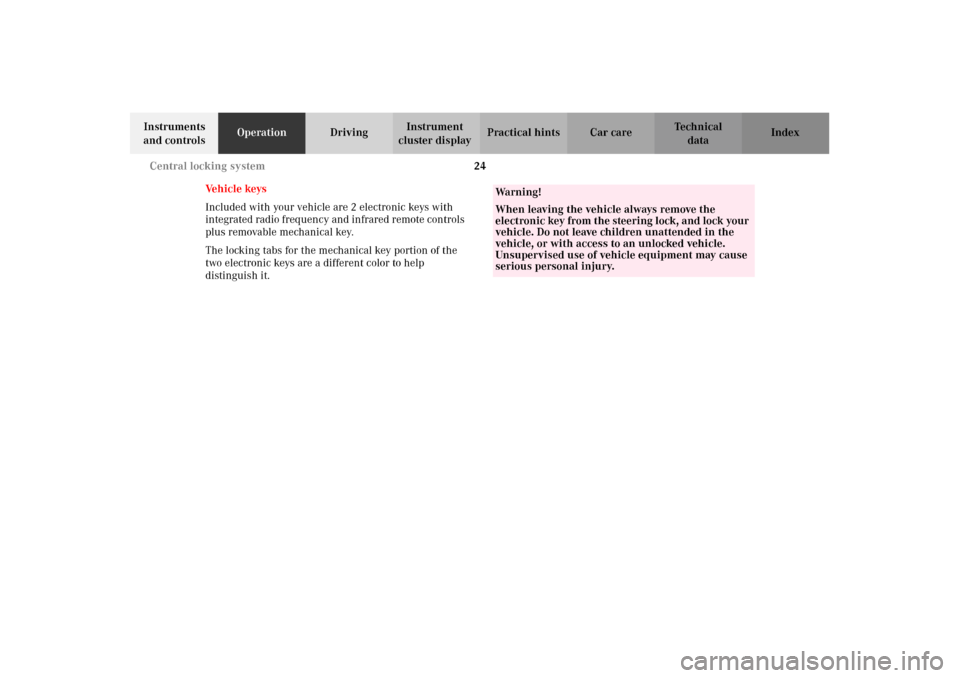
24 Central locking system
Technical
data Instruments
and controlsOperationDrivingInstrument
cluster displayPractical hints Car care Index
Ve h i c l e k e y s
Included with your vehicle are 2 electronic keys with
integrated radio frequency and infrared remote controls
plus removable mechanical key.
The locking tabs for the mechanical key portion of the
two electronic keys are a different color to help
distinguish it.
Wa r n i n g !
When leaving the vehicle always remove the
electronic key from the steering lock, and lock your
vehicle. Do not leave children unattended in the
vehicle, or with access to an unlocked vehicle.
Unsupervised use of vehicle equipment may cause
serious personal injury.
J_A208.book Seite 24 Donnerstag, 31. Mai 2001 9:35 09
Page 87 of 346
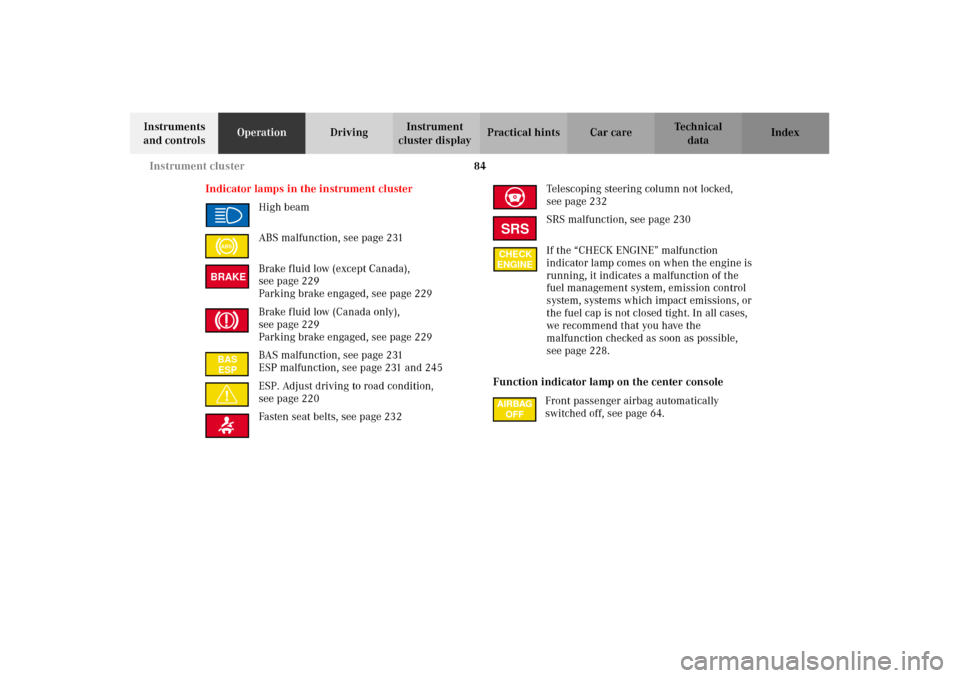
84 Instrument cluster
Technical
data Instruments
and controlsOperationDrivingInstrument
cluster displayPractical hints Car care Index
Indicator lamps in the instrument cluster
High beam
ABS malfunction, see page 231
Brake fluid low (except Canada),
seepage229
Parking brake engaged, see page 229
Brake fluid low (Canada only),
seepage229
Parking brake engaged, see page 229
BAS malfunction, see page 231
ESP malfunction, see page 231 and 245
ESP. Adjust driving to road condition,
seepage220
Fasten seat belts, see page 232Telescoping steering column not locked,
seepage232
SRS malfunction, see page 230
If the “CHECK ENGINE” malfunction
indicator lamp comes on when the engine is
running, it indicates a malfunction of the
fuel management system, emission control
system, systems which impact emissions, or
the fuel cap is not closed tight. In all cases,
we recommend that you have the
malfunction checked as soon as possible,
seepage228.
Function indicator lamp on the center console
Front passenger airbag automatically
switched off, see page 64.
ABSBRAKEBAS
ESP
SRSCHECK
ENGINE
J_A208.book Seite 84 Donnerstag, 31. Mai 2001 9:35 09
Page 180 of 346
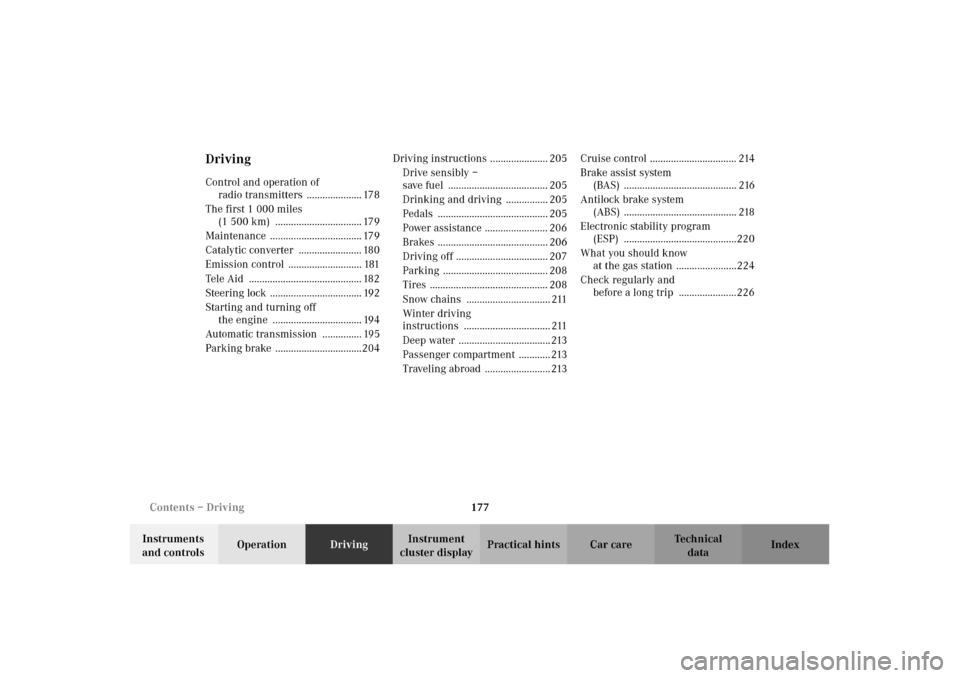
177 Contents – Driving
Technical
data Instruments
and controlsOperationDrivingInstrument
cluster displayPractical hints Car care Index
DrivingControl and operation of
radio transmitters ..................... 178
The first 1 000 miles
(1 500 km) ................................. 179
Maintenance ................................... 179
Catalytic converter ........................ 180
Emission control ............................ 181
Tele Aid ........................................... 182
Steering lock ................................... 192
Starting and turning off
the engine .................................. 194
Automatic transmission ............... 195
Parking brake .................................204Driving instructions ...................... 205
Drive sensibly –
save fuel ...................................... 205
Drinking and driving ................ 205
Pedals .......................................... 205
Power assistance ........................ 206
Brakes .......................................... 206
Driving off ................................... 207
Parking ........................................ 208
Tires ............................................. 208
Snow chains ................................ 211
Winter driving
instructions ................................. 211
Deep water ...................................213
Passenger compartment ............ 213
Traveling abroad ......................... 213Cruise control ................................. 214
Brake assist system
(BAS) ........................................... 216
Antilock brake system
(ABS) ........................................... 218
Electronic stability program
(ESP) ...........................................220
What you should know
at the gas station .......................224
Check regularly and
before a long trip ......................226
J_A208.book Seite 177 Donnerstag, 31. Mai 2001 9:35 09
Page 200 of 346

197 Automatic transmission
Technical
data Instruments
and controlsOperationDrivingInstrument
cluster displayPractical hints Car care Index Stopping
For brief stops, e.g. at traffic lights, leave the
transmission in gear and hold vehicle with the service
brake.
For longer stops with the engine idling, shift into “N”
or “P” and hold the vehicle with the service brake.
When stopping the vehicle on an uphill gradient, do not
hold it with the accelerator, use the brake. This avoids
unnecessary transmission heat build up.
Maneuvering
To maneuver in tight areas, e.g. when pulling into a
parking space, control the vehicle speed by gradually
releasing the brakes. Accelerate gently and never
abruptly step on the accelerator.
To rock a vehicle out of soft ground (mud or snow),
alternately shift from forward to reverse, while applying
slight partial throttle.Rocking a vehicle free in this manner may cause the
ABS or traction system malfunction indicator lamp to
come on. Turn off and restart the engine to clear the
malfunction indication.
Wa r n i n g !
Getting out of your vehicle with the selector lever
not fully engaged in position “P” is dangerous.
Also, when parked on an incline, position “P” alone
may not prevent your vehicle from moving,
possibly hitting people or objects.Always set the parking brake in addition to shifting
to position “P”, see page 204 for parking brake. When parked on an incline, also turn front wheel
against curb.Wa r n i n g !
When leaving the vehicle, always remove the
electronic key from the steering lock, and lock the
vehicle. Do not leave children unattended in the
vehicle, or with access to an unlocked vehicle.
Children could move the gear selector lever from
position “P”, which could result in an accident or
serious personal injury.
J_A208.book Seite 197 Donnerstag, 31. Mai 2001 9:35 09
Page 203 of 346
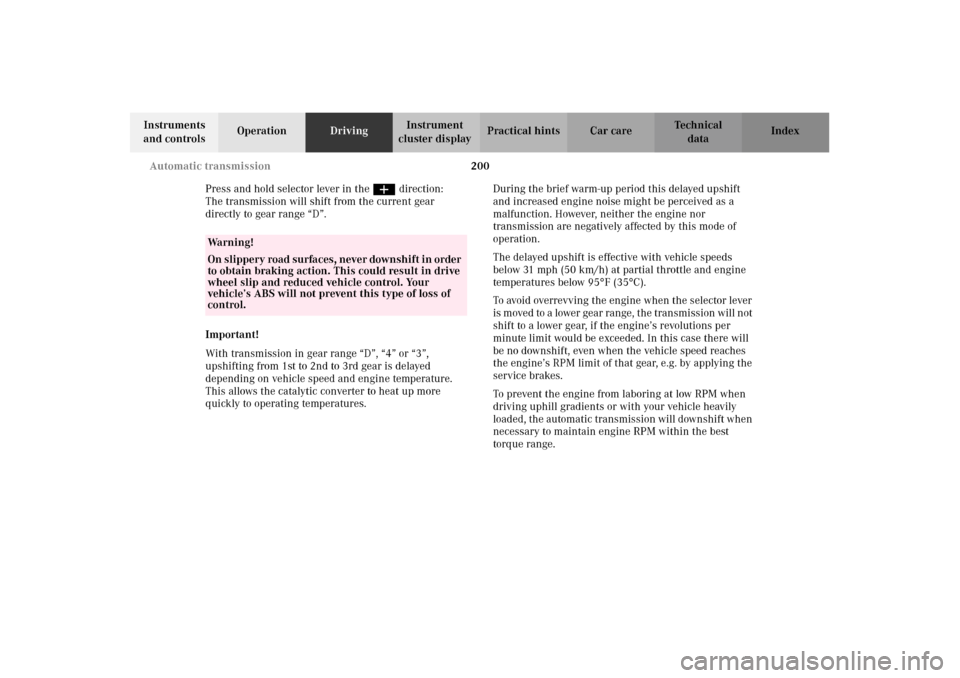
200 Automatic transmission
Technical
data Instruments
and controlsOperationDrivingInstrument
cluster displayPractical hints Car care Index
Press and hold selector lever in the æ direction:
The transmission will shift from the current gear
directly to gear range “D”.
Important!
With transmission in gear range “D”, “4” or “3”,
upshifting from 1st to 2nd to 3rd gear is delayed
depending on vehicle speed and engine temperature.
This allows the catalytic converter to heat up more
quickly to operating temperatures.During the brief warm-up period this delayed upshift
and increased engine noise might be perceived as a
malfunction. However, neither the engine nor
transmission are negatively affected by this mode of
operation.
The delayed upshift is effective with vehicle speeds
below 31 mph (50 km/h) at partial throttle and engine
temperatures below 95
°F (35
°C).
To avoid overrevving the engine when the selector lever
is m ove d to a lower gear range , t he tran smi ss ion will n ot
shift to a lower gear, if the engine’s revolutions per
minute limit would be exceeded. In this case there will
be no downshift, even when the vehicle speed reaches
the engine’s RPM limit of that gear, e.g. by applying the
service brakes.
To prevent the engine from laboring at low RPM when
driving uphill gradients or with your vehicle heavily
loaded, the automatic transmission will downshift when
necessary to maintain engine RPM within the best
torque range.
Wa r n i n g !
O n s l i p p e ry ro a d s u rfa c es , n eve r d ow n s h i f t i n o rd e r
to obtain braking action. This could result in drive
wheel slip and reduced vehicle control. Your
vehicle’s ABS will not prevent this type of loss of
control.
J_A208.book Seite 200 Donnerstag, 31. Mai 2001 9:35 09
Page 216 of 346
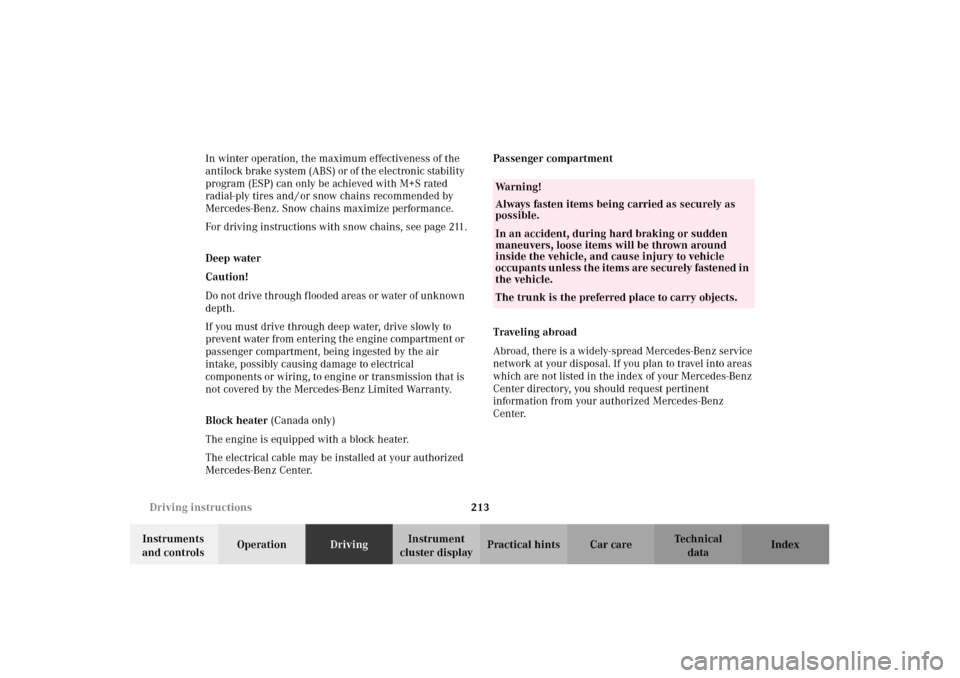
213 Driving instructions
Technical
data Instruments
and controlsOperationDrivingInstrument
cluster displayPractical hints Car care Index In winter operation, the maximum effectiveness of the
antilock brake system (ABS) or of the electronic stability
program (ESP) can only be achieved with M+S rated
radial-ply tires and / or snow chains recommended by
Mercedes-Benz. Snow chains maximize performance.
For driving instructions with snow chains, see page 211.
Deep water
Caution!
Do not drive through flooded areas or water of unknown
depth.
If you must drive through deep water, drive slowly to
prevent water from entering the engine compartment or
passenger compartment, being ingested by the air
intake, possibly causing damage to electrical
components or wiring, to engine or transmission that is
not covered by the Mercedes-Benz Limited Warranty.
Block heater (Canada only)
The engine is equipped with a block heater.
The electrical cable may be installed at your authorized
Mercedes-Benz Center.Passenger compartment
Traveling abroad
Abroad, there is a widely-spread Mercedes-Benz service
network at your disposal. If you plan to travel into areas
which are not listed in the index of your Mercedes-Benz
Center directory, you should request pertinent
information from your authorized Mercedes-Benz
Center.
Wa r n i n g !
Always fasten items being carried as securely as
possible.In an accident, during hard braking or sudden
maneuvers, loose items will be thrown around
inside the vehicle, and cause injury to vehicle
oc cu pa nt s u nl ess t he i tem s are s ecurely fastened i n
the vehicle.The trunk is the preferred place to carry objects.
J_A208.book Seite 213 Donnerstag, 31. Mai 2001 9:35 09
Page 219 of 346
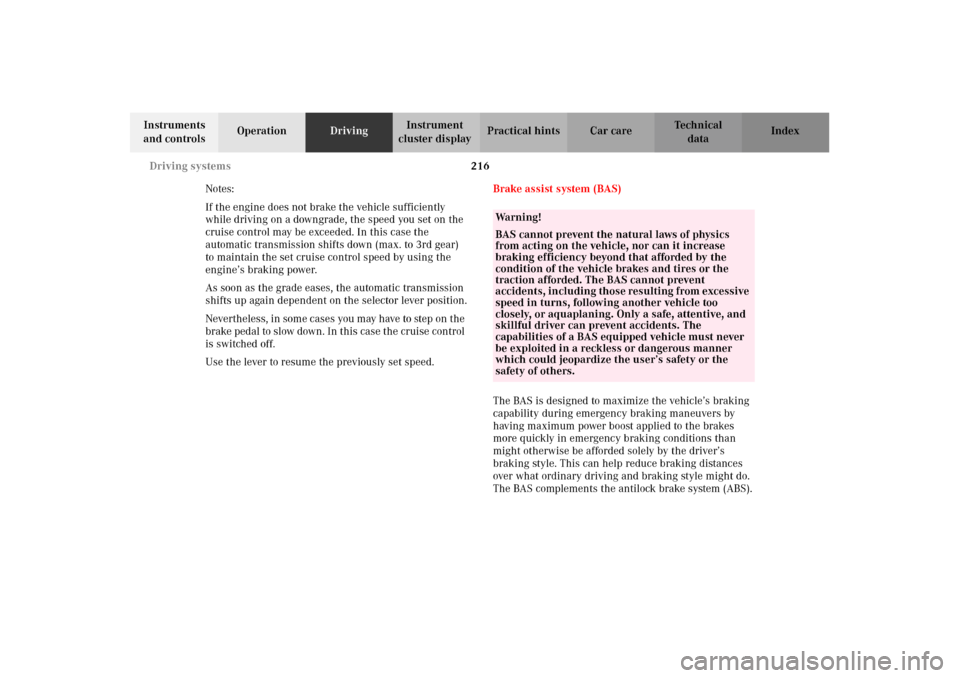
216 Driving systems
Technical
data Instruments
and controlsOperationDrivingInstrument
cluster displayPractical hints Car care Index
Notes:
If the engine does not brake the vehicle sufficiently
while driving on a downgrade, the speed you set on the
cruise control may be exceeded. In this case the
automatic transmission shifts down (max. to 3rd gear)
to maintain the set cruise control speed by using the
engine’s braking power.
As soon as the grade eases, the automatic transmission
shifts up again dependent on the selector lever position.
Nevertheless, in some cases you may have to step on the
brake pedal to slow down. In this case the cruise control
is switched off.
Use the lever to resume the previously set speed.Brake assist system (BAS)
The BAS is designed to maximize the vehicle’s braking
capability during emergency braking maneuvers by
having maximum power boost applied to the brakes
more quickly in emergency braking conditions than
might otherwise be afforded solely by the driver’s
braking style. This can help reduce braking distances
over what ordinary driving and braking style might do.
The BAS complements the antilock brake system (ABS).
Wa r n i n g !
BAS cannot prevent the natural laws of physics
from acting on the vehicle, nor can it increase
braking efficiency beyond that afforded by the
condition of the vehicle brakes and tires or the
traction afforded. The BAS cannot prevent
accidents, including those resulting from excessive
speed in turns, following another vehicle too
closely, or aquaplaning. Only a safe, attentive, and
skillful driver can prevent accidents. The
capabilities of a BAS equipped vehicle must never
be exploited in a reckless or dangerous manner
which could jeopardize the user’s safety or the
safety of others.
J_A208.book Seite 216 Donnerstag, 31. Mai 2001 9:35 09